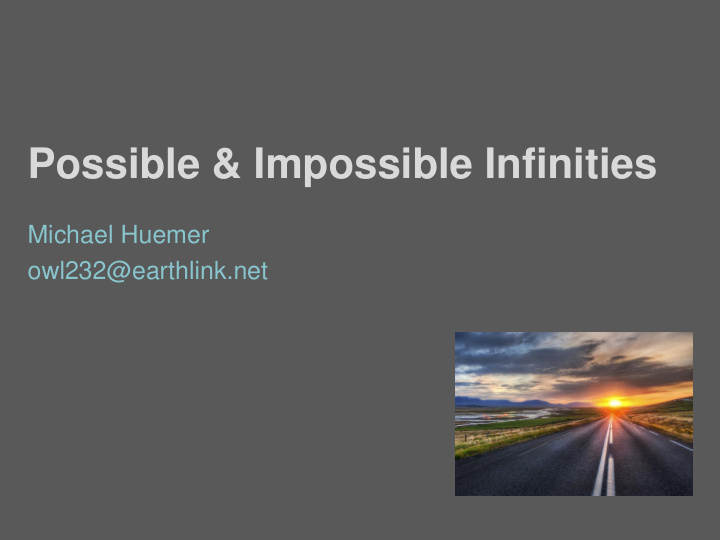



Possible & Impossible Infinities Michael Huemer owl232@earthlink.net
Problem When is an infinite series impossible? 6 Infinite 3 False A Better Series Theories Theory
Six Infinities The Truth Regress Series: P. It’s true that P. It’s true that it’s true that P. . . . Generated by principle: P ➞ It is true that P. Verdict: Benign.
Six Infinities The Endless Zeno Series Series: 1/2 3/4 7/8 . . . Generated by principle: To travel some distance, one must first travel half the distance. Verdict: Benign.
Six Infinities Variant: The beginningless Zeno Series … Series: 1/8 1/4 1/2 Generated by principle: To travel some distance, one must first travel half the distance. Verdict: Benign.
Six Infinities Thomson ’ s Lamp Series: Off t=0 On t=1/2 Off t=3/4 . . . Puzzle: At the end of the series, is it on or off? Verdict: Impossible.
Six Infinities The Littlewood-Ross Banker Start: infinite pile of $1 bills, bills # 1, 2, 3, ... Series: $9 bills 2-10 $18 bills 3-20 $27 bills 4-30 . . . Puzzle: At the end of the series, how much money do you have? Verdict: Impossible.
Six Infinities The Regress of Causes Series: A The cause of A The cause of the cause of A . . . Generated by principle: Every event has a cause; every cause is an event. Verdict: Controversial.
Six Infinities The Regress of Reasons Series: P The reason for P The reason for the reason for P . . . Generated by principle: Every justified belief has a reason; every reason is a justified belief. Verdict: Controversial.
Six Infinities Desired: A criterion of the impossible infinite that a) Has some plausible theoretical rationale b) Classifies the Truth Regress and Zeno ’ s Series as benign c) Classifies Thomson ’ s Lamp and the Littlewood-Ross Banker as impossible Regresses of causes and epistemic reasons are negotiable.
Three Failed Criteria Theory #1: There can be potential infinities, but no actual infinities. Counter-examples Truth regress The Zeno series
Three Failed Criteria Theory #2: An infinite series cannot be completed by successive addition. Counter-example : The endless Zeno series
Three Failed Criteria Theory #3: An infinite series is vicious when each member depends on the next. Counter-example : The beginningless Zeno series
A New Theory of the Vicious Infinite Theory: There cannot be an infinite, natural, intensive magnitude. Explanation: Two kinds of quantities: Cardinal numbers: 0, 1, 2, ... , א 0 , ... Magnitudes: (represented by real #s)
A New Theory of the Vicious Infinite Theory: There cannot be an infinite, natural, intensive magnitude. Two kinds of magnitudes: Extensive: Additive across parts. Length, duration, volume, ... Intensive: Not additive across parts. Temperature, density, velocity, ...
A New Theory of the Vicious Infinite Theory: There cannot be an infinite, natural, intensive magnitude. Two kinds of quantities: Natural: Real properties of objects. (Usually) causally efficacious. Artificial: Stipulative, may involve mathematical operations that lack physical significance. Non-causal.
Classifying Cases Thomson’s Lamp: Forces/accelerations increase without bound; hence... Infinite material strength Infinite energy density Infinite speed
Classifying Cases Variation on Thomson ’ s Lamp: The switch is a dial. At 0 degrees, lamp is on. All other positions are off. Off: On: Diagnosis: This series is possible, but not paradoxical. – In the end, the lamp is on.
Classifying Cases Littlewood-Ross Banker: Impossible for similar reasons as Thomson’s Lamp.
Classifying Cases Zeno: Infinite # of stages. All real physical magnitudes finite. (length, time, velocity, energy, …
Classifying Cases Truth regress: Infinite # of propositions: no problem. p T(p) T(T(p)) …
Theoretical Rationale Fundamentally, there are only finite numbers. There is not a number larger than every real number. Claims about the infinite must be restatable in terms of finite numbers.
Theoretical Rationale Why are infinite cardinalities allowed? S has infinite cardinality = df for any natural number n , S contains a subset with more than n members. Conceptually, this only commits us to the existence of natural numbers.
Theoretical Rationale Why are infinite extensive magnitudes allowed? x has an infinite amount of extensive magnitude M = df For any real magnitude m of M , x possesses a part whose quantity of M is greater than m . Example: Space is infinite = for any chosen volume v , there is a part of space with volume greater than v . Conceptually, this only commits us to the existence of finite magnitudes.
Theoretical Rationale Why can there not be an infinite intensive magnitude? The preceding analytical strategy fails for intensive magnitudes, since intensive magnitudes do not compound over parts. An ascription of infinite intensive magnitude requires that there be a number greater than all real numbers.
Theoretical Rationale Why consider only natural magnitudes? Artificial magnitudes could do anything. 1 Ex.: define schmass to be 3−mass . When mass=3, schmass= ∞ .
The Controversial Cases The regress of causes No reason why this could not exist. The regress of reasons No reason why this could not exist. This is not to say that it’s plausible.
Some Other Paradoxes Hilbert’s Hotel Benardete’s paradoxes St. Petersburg Laraudogoitia’s paradox The spaceship
Further Reading Michael Huemer, Approaching Infinity (New York: Palgrave Macmillan, 2016)
End.
Recommend
More recommend